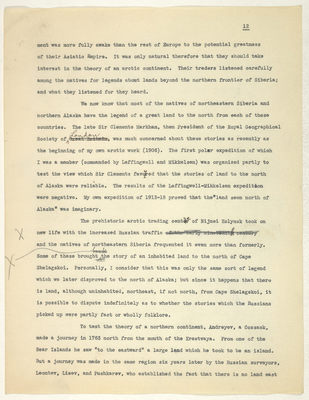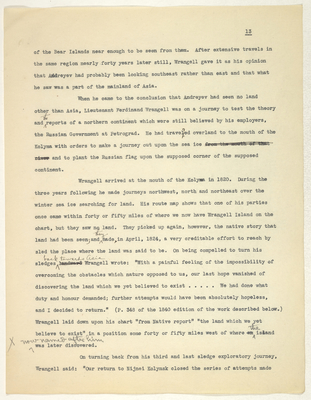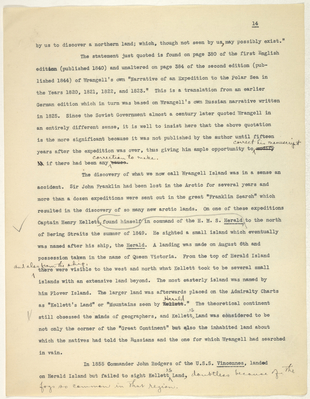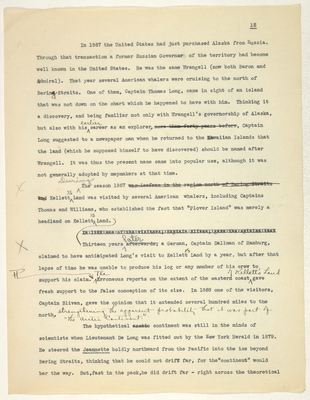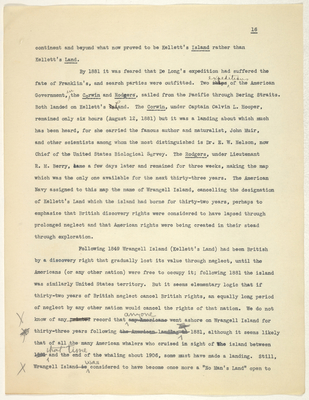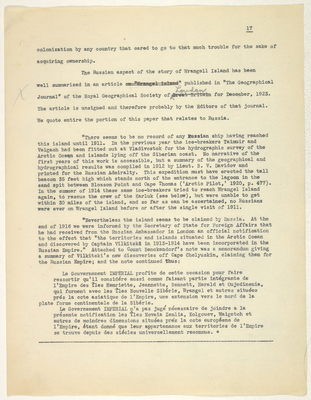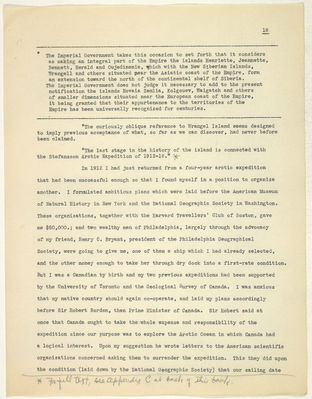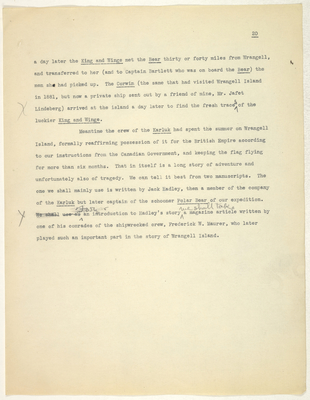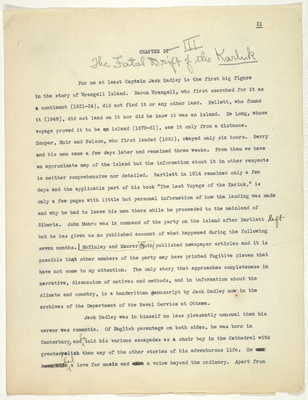Pages That Need Review
stefansson-wrangel-09-26-001
stefansson-wrangel-09-26-001-017
12
ment was more fully awake than the rest of Europe to the potential greatness of their Asiatic Empire. It was only natural therefore that they should take interest in the theory of an arctic continent. Their traders listened carefully among the natives for legends about lands beyond the northern frontier of Siberia; and what they listened for they heard.
We now know that most of the natives of northeastern Siberia and northern Alaska have the legend of a great land to the north from each of these countries. The late Sir Clements Markham, then President of the Royal Geographical Society of London was much concerned about these stories as recently as the beginning of my own arctic work (1906). The first polar expedition of which I was a member (commanded by Leffingwell and Mikkelsen) was organized partly to test the view which Sir Clements favoured that the stories of land to the north of Alaska were reliable. The results of the Leffingwell-Mikkelson expedition were negative, My own expedition of 1913-18 proved that the"land seen north of Alaska" was imaginary.
The prehistoric arctic trading center of Nijnei Kolymsk took on new life with the increased Russian traffic of the early nineteenth century and the natives of northeastern Siberia frequented it even more than formerly. Some of these brought the story of an inhabited land to the north of Cape Shelagskoi. Personally, I consider that this was only the same sort of legend which we later disproved to the north of Alaska; but since it happens that there is land, although uninhabited, northeast, if not north, from Cape Shelagskoi, it is possible to dispute indefinitely as to whether the stories which the Russians picked up were partly fact or wholly folklore.
To test the theory of a northern continent, Andreyev, a Cossack, made a journey in 1763 north from the mouth of the Krestvaya. From one of the Bear Islands he saw "to the eastward" a large land which he took to be an island. But a journey was made in the same region six years later by the Russian surveyors, Leontev, Lisev, and Pushkarev, who established the fact that there is no land east
stefansson-wrangel-09-26-001-018
13
of the Bear Islands near enough to be seen from them. After extensive travels in the same region nearly forty years later still, Wrangell gave it as his opinion that Andreyev had probably been looking southeast rather than east and that what he saw was a part of the mainland of Asia.
When he came to the conclusion that Andreyev had seen no land other than Asia, Lieutenant Ferdinand Wrangell was on a journey to test the theory and [the] reports of a northern continent which were still believed by his employers, the Russian Government at Petrograd. He had traveled overland to the mouth of the Kolyma with orders to make a journey out upon the sea ice from the mouth of that river and to plant the Russian flag upon the supposed corner of the supposed continent.
Wrangell arrived at the mouth of the Kolyma in 1820. Luring the three years following he made journeys northwest, north and northeast over the winter sea ice searching for land. His route map shows that one of his parties once came within forty or fifty miles of where we now have Wrangell Island on the chart, but they saw no land. They picked up again, however, the native story that land had been seen; and they made, in April, 1824, a very creditable effort to reach by sled the place where the land was said to be. On being compelled to turn his sledges back towards asia Wrangell wrote: "With a painful feeling of the impossibility of overcoming the obstacles which nature opposed to us, our last hope vanished of discovering the land which we yet believed to exist ..... We had done what duty and honour demanded; further attempts would have been absolutely hopeless, and I decided to return." (P. 348 of the 1840 edition of the work described below.) Wrangell laid down upon his chart "from native report" "the land which we yet believe to exist" in a position some forty or fifty miles west of an the island now named after him was later discovered.
On turning back from his third and last sledge exploratory journey, Wrangell said: "Our return to Nijnei Kolymsk closed the series of attempts made
stefansson-wrangel-09-26-001-019
14
by us to discover a northern land; which, though not seen by us, may possibly exist."
The statement just quoted is found on page 380 of the first English edition (published 1840) and unaltered on page 384 of the second edition (published 1844) of Wrangell's own “Narrative of an Expedition to the Polar Sea in the Years 1820, 1821, 1822, and 1823." This is a translation from an earlier German edition which in turn was based on Wrangell’s own Russian narrative written in 1825. Since the Soviet Government almost a century later quoted Wrangell in an entirely different sense, it is well to insist here that the above quotation is the more significant because it was not published by the author until fifteen years after the expedition was over, thus giving him ample opportunity to correct his manuscript if there had been any correction to make.
The discovery of what we now call Wrangell Island was in a sense an accident. Sir John Franklin had been lost in the Arctic for several years and more than a dozen expeditions were sent out in the great "Franklin Search" which resulted in the discovery of so many new arctic lands. On one of these expeditions Captain Henry Kellett, found himself in command of the H. M. S. Herald to the north of Bering Straits the summer of 1849. He sighted a small island which eventually was named after his ship, the Herald. A landing was made on August 6th and possession taken in the name of Queen Victoria. From the top of Herald Island and also from the ship, there were visible to the west and north what Kellett took to be several small islands with an extensive land beyond. The most easterly island was named by him Plover Island. The larger land was afterwards placed on the Admiralty Charts as "Kellett's Land" or "Mountains seen by Herald." The theoretical continent still obsessed the minds of geographers, and Kellett's Land was considered to be not only the corner of the "Great Continent" but also the inhabited land about which the natives had told the Russians and the one for which Wrangell had searched in vain.
In 1855 Commander John Rodgers of the U.S.S. Vincennes, landed on Herald Island but failed to sight Kellett's Land, doubtless because of the fogs so common in that region.
stefansson-wrangel-09-26-001-020
15 In 1867 the United States had just purchased Alaska from Russia. Through that transaction a former Russian Governor of the territory had become well known in the United States. He was the same Wrangell (now both Baron and Admiral). That year several American whalers were cruising to the north of Bering Straits. One of them, Captain Thomas Long, came in sight of an island that was not down on the chart which he happened to have with him. Thinking it a discovery, and being familiar not only with Wrangell's governorship of Alaska, but also with his earlier career as an explorer, more than forty years before, Captain Long suggested to a newspaper man when he returned to the Hawaiian Islands that the land (which he supposed himself to have discovered) should be named after Wrangell. It was thus the present name came into popular use, although it was not generally adopted by mapmakers at that time.
During the season 1867 was icefree in the region north of Bering Straits and Kellett's Land was visited by several American whalers, including Captains Thomas and Williams, who established the fact that "Plover Island" was merely a headland on Kellett's Land.
Thirteen years afterwards later a German, Captain Dallman of Hamburg, claimed to have anticipated Long's visit to Kellett's Land by a year, but after that lapse of time he was unable to produce his log or any member of his crew to, support his claim. The erroneous reports on the extent of the eastern coast of Kellett's Land gave fresh support to the false conception of its size. In 1869 one of the visitors, Captain Bliven, gave the opinion that it extended several hundred miles to the north, strengthening the apparent probability that it was part of "The Arctic Continent."
The hypothetical arctic continent was still in the minds of scientists when Lieutenant De Long was fitted out by the New York Herald in 1879. He steered the Jeannette boldly northward from the Pacific into the ice beyond Bering Straits, thinking that he could not drift far, for the "continent" would bar the way. But,fast in the pack,he did drift far - right across the theoretical
stefansson-wrangel-09-26-001-021
16
continent and beyond what now proved to be Kellett's Island rather than Kellett's Land.
By 1881 it was feared that De Long's expedition had suffered the fate of Franklin's, and search parties were outfitted. Two ships, expiditions of the American Government, in the Corwin and Rodgers, sailed from the Pacific through Bering Straits. Both landed on Kellett's island Land. The Corwin, under Captain Calvin L. Hooper, remained only six hours (August 12, 1881) but it was a landing about which much has been heard, for she carried the famous author and naturalist, John Muir, and other scientists among whom the most distinguished is Dr. E. W. Nelson, now Chief of the United States Biological Survey. The Rodgers, under Lieutenant R. M. Berry, came a few days later and remained for three weeks, making the map which was the only one available for the next thirty-three years. The American Navy assigned to this map the name of Wrangell Island, cancelling the designation of Kellett's Land which the island had borne for thirty-two years, perhaps to emphasize that British discovery rights were considered to have lapsed through prolonged neglect and that American rights were being created in their stead through exploration.
Following 1849 Wrangell Island (Kellett's Land) had been British by a discovery right that gradually lost its value through neglect, until the Americans (or any other nation) were free to occupy it; following 1881 the island was similarly United States territory. But it seems elementary logic that if thirty-two years of British neglect cancel British rights, an equally long period of neglect by any other nation would cancel the rights of that nation. We do not know of any printedrecord that anyone say Americans went ashore on Wrangell Island for thirty-three years following the American landing in 1881, although it seems likely that of all the many American whalers who cruised in sight of the island between 1881 that timeand the end of the whaling about 1906, some must have made a landing. Still, Wrangell Island is was considered to have become once more a "No Man's Land" open to
stefansson-wrangel-09-26-001-022
17
colonization by any country that cared to go to that much trouble for the sake of acquiring ownership.
The Russian aspect of the story of Wrangell Island has been well summarized in an article on "Wrangel Island"published in "The Geographical Journal" of the Royal Geographical Society of Great Britain London for December, 1923. The article is unsigned and therefore probably by the Editors of that journal. We quote entire the portion of this paper that relates to Russia.
“There seems to be no record of any Russian ship having reached this island until 1911. In the previous year the ice-breakers Taimuir and Vaigach had been fitted out at Vladivostok for the hydrographic survey of the Arctic Ocean and islands lying off the Siberian coast. No narrative of the first years of this work is accessible, but a summary of the geographical and hydrographical results was compiled in 1912 by Lieut. B. V. Davidov and printed for the Russian Admiralty. This expedition must have erected the tall beacon 35 feet high which stands north of the entrance to the lagoon in the sand spit between Blossom Point and Cape Thomas ('Arctic Pilot,' 1920, p. 477). In the summer of 1914 these same ice-breakers tried to reach Wrangel Island again, to rescue the crew of the Karluk (see below), but were unable to get within 30 miles of the island, and so far as can be ascertained, no Russians were ever on Wrangel Island before or after the single visit of 1911.
"Nevertheless the island seems to be claimed by Russia. At the end of 1916 we were informed by the Secretary of State for Foreign Affairs that he had received from the Russian Ambassador in London an official notification to the effect that "the territories and islands situated in the Arctic Ocean and discovered by Captain Vilkitski in 1913-1914 have been incorporated in the Russian Empire." Attached to Count Benckendorf's note was a memorandum giving a summary of Vilkitski's new discoveries off Cape Chelyuskin, claiming them for the Russian Empire; and the note continued thus:
Le Gouvernement IMPERIAL profite de cette occasion pour faire ressortir qu'il considdre aussi comme faisant partie intdgrante de l'Empire des iles Henriette, Jeannette, Bennett, Herald et Gujedinenia, qui forment avec les iles Nouvelle Sibdrie, Wrangel et autres situees pres la cote asiatique de l'Empire, une extension vers le nord de la plate forme continentale de la Sibdrie.
Le Governement IMPERIAL n'a pas juge necessaire de joindre a la presente notification les iles Novaia Zemlia, Kolgouev, Waigatch et autres de moindres dimensions situees pres la cote europdene de l'Empire, etant donne que leur appartenance aux territories de l'Empire se trouve depuis des siecles universellement reconnue. *
stefansson-wrangel-09-26-001-023
18
*The Imperial Government takes this occasion to set forth that it considers as making an integral part of the Empire the islands Henriette, Jeannette, Bennett, Herald and Oujedinenia, which with the New Siberian Islands, Wrangell and others situated near the Asiatic coast of the Empire, form an extension toward the north of the continental shelf of Siberia. The Imperial Government does not judge it necessary to add to the present notification the islands Novaia Zemlia, Kolgouev, Waigatch and others of smaller dimensions situated near the European coast of the Empire, it being granted that their appurtenance to the territories of the Empire has been universally recognized for centuries.
”The curiously oblique reference to Wrangel Island seems designed to imply previous acceptance of what, so far as we can discover, had never before been claimed.
"The last stage in the history of the island is connected with the Stefansson Arctic Expedition of 1913-18.” *
In 1912 I had just returned from a four-year arctic expedition that had been successful enough so that I found myself in a position to organize another. I formulated ambitious plans which were laid before the American Museum of Natural History in New York and the National Geographic Society in Washington. These organizations, together with the Harvard Travellers' Club of Boston, gave me $50,000.; and two wealthy men of Philadelphia, largely through the advocacy of my friend, Henry C. Bryant, president of the Philadelphia Geographical Society, were going to give me, one of them a ship which I had already selected, and the other money enough to take her through dry dock into a first-rate condition. But I was a Canadian by birth and my two previous expeditions had been supported by the University of Toronto and the Geological Survey of Canada. I was anxious that my native country should again co-operate, and laid my plans accordingly before Sir Robert Borden, then Prime Minister of Canada. Sir Robert said at once that Canada ought to take the whole expense and responsibility of the expedition since our purpose was to explore the Arctic Ocean in which Canada had a logical interest. Upon my suggestion he wrote letters to the American scientific organizations concerned asking them to surrender the expedition. This they did upon the condition (laid down by the National Geographic Society) that our sailing date *For full text, see appendix C at back of this book.
stefansson-wrangel-09-26-001-024
19
must not be delayed beyond 1913 and that the scientific program of the expedition should remain substantially as already outlined by me.
When we sailed north in the spring of 1913 one paragraph of our orders from the Canadian Government instructed us to plant the British flag on any new or partly unknown lands which the expedition should touch. This brought us into direct relation with Wrangell Island, a land originally discovered by a British naval expedition.
However, we did not have the intention to sail for Wrangell Island. Indeed, our plan was to go in a different direction, but Fate took a hand. The ice hemmed in one of our ships, the Karluk, late in the summer of 1913, and carried her a prisoner west along the north coast of Alaska and then in the direction of Wrangell Island, near which she sank in January, 1914, the men landing early in March. Our expedition at this stage had three ships. I was with the other two at Collinson Foint, in northeastern Alaska, ignorant for more than a year of the fate of the Karluk, which was under the charge of her sailing master, Captain Robert A. Bartlett, a native of Newfoundland and in Canadian employ although then recently become a naturalized citizen of the United States. After making a landing on Wrangell, Captain Bartlett instructed his men to remain there, while he, with one companion, crossed the hundred mile ice bridge to the European and native settlements of Siberia and then proceeded seven hundred miles across country to Emma Harbor to send out a wireless call for help.
Many ships responded. The Russian Government instructed their ice-breakers, Taimyr and Vaigatch, to proceed to Wrangell Island. They had not been able to get within sight of the island, however, when they received a wireless telling that the Great War had started and that they must return south. The United States revenue cutter Bear made an attempt but also failed. Several private ships tried. The successful one was the King and Winge under her owner, Olaf Swenson, who had been induced to make the attempt by Burt M. McConnell, a former member of our expedition. Her Captain, A.T.P. Jochimsen, was used to the sort of ice he had to contend with and wormed his way up to the island. Southward bound
stefansson-wrangel-09-26-001-025
20
a day later the King and Winge met the Bear thirty or forty miles from Wrangell, and transferred to her (and to Captain Bartlett who was on board the Bear) the men she had picked up. The Corwin (the same that had visited Wrangell Island in 1881, but now a private ship sent out by a friend of mine, Mr. Jafet Lindeberg) arrived at the island a day later to find the fresh traces of the luckier King and Winge.
Meantime the crew of the Karluk had spent the summer on Wrangell Island, formally reaffirming possession of it for the British Empire according to our instructions from the Canadian Government, and keeping the flag flying for more than six months. That in itself is a long story of adventure and unfortunately also of tragedy. We can tell it best from two manuscripts. The one we shall mainly use is written by Jack Hadley, then a member of the company of the Karluk but later captain of the schooner Polar Bear of our expedition. We shall use as [For] an introduction to Hadley's story we shall take a magazine article written by one of his comrades of the shipwrecked crew, Frederick W. Maurer, who later played such an important part in the story of Wrangell Island.
stefansson-wrangel-09-26-001-026
21
CHAPTER II III The Fatal Drift of the Karluk
For me at least Captain Jack Hadley is the first big figure in the story of Wrangell Island. Baron Wrangell, who first searched for it as a continent (1821-24), did not find it or any other land. Kellett, who found it (1849), did not land on it nor did he know it was an island. De Long, whose voyage proved it to be an island (1879-81), saw it only from a distance. Hooper, Muir and Nelson, who first landed (1881), stayed only six hours. Berry and his men came a few days later and remained three weeks. From them we have an approximate map of the island but the information about it in other respects is neither comprehensive nor detailed. Bartlett in 1914 remained only a few days and the applicable part of his book "The Last Voyage of the Karluk," is only a few pages with little but personal information of how the landing was made and why he had to leave his men there while he proceeded to the mainland of Siberia. John Munro was in command of the party on the island after Bartlett left but he has given us no published account of what happened during the following seven months. [ McKinlay and Maurer both published newspaper articles and it is possible that other members of the party may have printed fugitive pieces that have not come to my attention. The only story that approaches completeness in narrative, discussion of motives and methods, and in information about the climate and country, is a handwritten Manuscript by Jack Hadley now in the archives of the Department of the Naval Service at Ottawa.
Jack Hadley was in himself no less pleasantly unusual than his career was romantic. Of English parentage on both sides, he was born in Canterbury, and he told his various escapades as a choir boy in the Cathedral with greater relish than any of the other stories of his adventurous life. He was born with had a love for music and with a voice beyond the ordinary. Apart from
